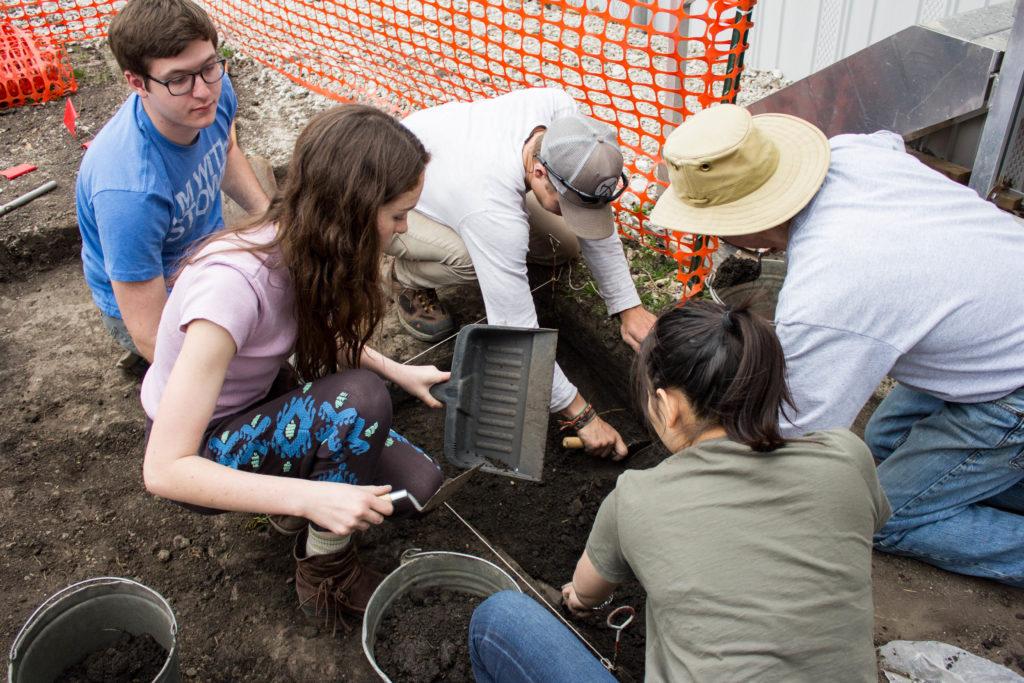
When local historian Byron Hueftle-Worley came across an article detailing an explosion on Grinnell’s campus, it naturally sparked his interest.
“Dynamite seems to be the agent used by the attacking party, judging from the sound of the explosion which awakened the inhabitants of North Grinnell at a late hour that night,” read the S&B article from April 22, 1914. The target of the blast was something referred to as the “Scrap Rock,” which, according to the article, was “considerably diminished in size and marred as to beauty.”
Hueftle-Worley had just stumbled upon a forgotten piece of Grinnell history that had the potential to be explosive.
“I was researching another historic question that has nothing to do with this, but that involved going through the old papers and skimming every article … and I came across a mention of a dynamite blast on campus … so I read it. But I didn’t know what a ‘scrap’ was, didn’t know what a ‘peace rock’ was,” Hueftle-Worley said.
By going through more archives of the S&B from around the turn of the 20th century, Hueftle-Worley soon learned more about this mysterious “scrap.” A college tradition dating from the 1880s, he describes the event as a “semi-sanctioned wrestling match”, but with a harder edge. Each year, on a day in September, men of the first year and second year classes would come to face each other on the lawns outside North campus, for a challenge that served to test the physical caliber of each class. Reportedly, if the first years won, they couldn’t be hazed for the rest of the year — a prize which certainly infused the match with spirit.
But with so much pride and masculine energy wrapped up in the event, the “scrap” couldn’t be contained to the manicured lawns outside Gates Tower. What began as an afternoon of wrestling soon took on a larger aura of mischief, as the underclassman upped the ante of the brawl.
“Wrestling matches, fighting matches, guerilla warfare in town, poisoning students with bromine and tearing up the steps of the school gymnasium, the stone steps, to lock in the guys who were in the building. Then the guys in the building breaking out a window to get out and continue to fight, which did not make the College happy. Nor did the poisoning with the bromine make them happy either,” Hueftle-Worley said, recounting the myriad ways in which students celebrated “scrap” season.
Unsurprisingly, many of the administrators, faculty and students were unhappy about the “scrap.” Broken bones and minor injuries were a staple of the tradition, but one year, in an incident that made the front page of national newspapers, a freshman was “disfigured for life” after some sophomores decided to “smoke him out” of a barn he was hiding in using bromides. This incident, and news that a man had actually died at a Wisconsin school in a similar tradition, prompted the College President John H.T. Main to give a stirring speech in chapel, rallying against the evils of the “scrap.”
“The two classes very quietly decided not to hold the scrap, and to do something to commemorate that. So several hundred people, apparently, were gathered on campus to watch the fight. Instead [the students] came in with this handcart with a rock on it, singing a song they had written for the event,” Hueftle-Worley explained.
The rock the students brought in was thereby dubbed the “Peace Rock,” or “Scrap Rock,” and was placed on campus as a memorial to the peace that the two classes had forged. Some of the upperclassman, however, didn’t appreciate this turn of events, and consequently took out their frustration on the young monument.
Several acts of vandalism were committed on the rock, the first being the painting of the granite boulder with red paint, the second the infamous dynamite blast that set Hueftle-Worley on the trail and the third and final act, the burying of the rock. Although John Whittaker, anthropology, says that many people at the time must have known where the rock was buried, it was never dug up. An article published in the Grinnell Herald on April 28, 1914 predicted that the stone would remain buried in the earth with “little hope of resurrection … entertained even by those who believe most faithfully in the significance of the fallen monument.” Consequently the “Peace Rock” and its story were lost underneath the ground.
That is, until now.
On Saturday, April 8, Whittaker, Hueftle-Worley and several students broke ground near the commencement stage behind the McGough construction trailer.
“Byron has poked around here over the years hoping to find the thing, and so now that this area is going to be torn up for the new landscaping, we figured it was time to do a proper excavation,” Whittaker said.
With the help of University of Iowa Professor Glenn Storey the team made use of a ground-penetrating radar, a tool that surveys the grounds with radio waves to search for irregularities. The team discovered a large anomaly in this corner of the quad, an anomaly that Whittaker assumed to be the Peace Rock. Photo evidence compiled by Huefte-Worley also confirmed that this should be the Peace Rock’s resting place.
But after several days of digging, the team came up short. Despite digging 50 centimeters into the earth where the radar indicated the anomaly, there was no sign of the historic stone. Just as the team was ready to call it quits, Hueftle-Wortley thought to try sticking a probe into another direction: right underneath the concrete sidewalk.
“Byron thought he’d stick the probe that we have in some other places, we’ve been probing around trying to find it. So he poked it there and it looks like it was something hard, and we’ve dug a quick little exploration, and it looks like the right kind of rock,” Whittaker said.
On Thursday, April 12, McGough construction helped uproot the sidewalk, revealing the Peace Rock in full. Whittaker hopes to have the rock fully exhumed by Monday, finally restoring the symbolic monument to its rightful place above-ground.
“It’s been a long process and now we’re going to have to excavate more, but it will be more rewarding now that there is something there,” said student archaeologist, Leah Harris ’19.
And so after 100 years, with the blood and sweat of many Grinnellians past and present and a little bit of luck, the Peace Rock will once again remind the campus community of the “scrappy” history of the student body.
“It’s been good training for the student; it’s been fun for me,” Whittaker said. “It’s an exciting opportunity and it’s such a fun story that should be told.”



































































